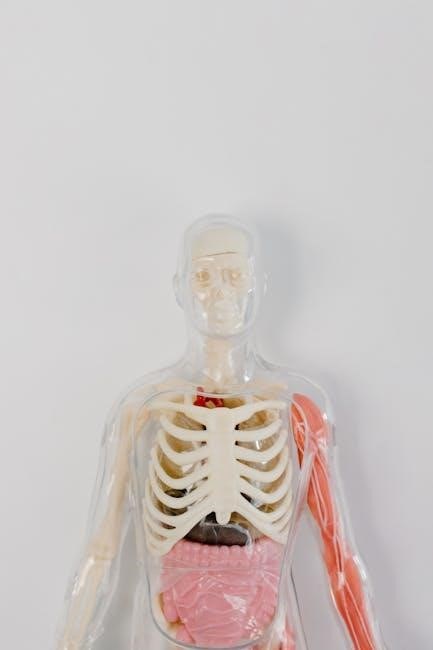Lab values are crucial in nursing practice, guiding patient assessment and care. Nurses rely on normal ranges to interpret results, ensuring accurate diagnoses and effective treatment plans.
Importance of Lab Values in Nursing Practice
Accurate interpretation of lab values is essential for patient assessment and care. Nurses use these values to monitor treatment efficacy, detect potential complications, and make informed clinical decisions. Lab results guide medication adjustments, fluid management, and interventions, ensuring personalized care. Understanding normal ranges helps identify abnormalities, enabling early intervention and improving patient outcomes. Lab values are a cornerstone of nursing practice, directly impacting patient safety and the quality of care provided.
Overview of Normal Lab Value Ranges
Normal lab value ranges vary by test and patient demographics. Common tests include CBC, electrolytes, and blood gases. For example, hemoglobin ranges are 13.5-17.5 g/dL for men and 12-15.5 g/dL for women. Electrolytes like sodium (135-145 mmol/L) and potassium (3.5-5.0 mmol/L) are critical for fluid balance. Blood gases, such as pH (7.35-7.45), PaO2 (80-100 mmHg), and PaCO2 (35-45 mmHg), reflect respiratory and acid-base status. These ranges guide nurses in assessing normal vs. abnormal results, ensuring timely interventions.
Blood Gases
Blood gases measure oxygenation, ventilation, and acid-base balance. Key components include pH, PaO2, PaCO2, and HCO3, with normal ranges indicating respiratory and metabolic function status.
pH Levels
pH levels measure blood acidity, with a normal range of 7.35-7.45. Values below 7.35 indicate acidosis, while above 7.45 suggest alkalosis. Nurses monitor pH to assess acid-base balance, crucial for detecting respiratory or metabolic disorders. Accurate interpretation aids in early intervention, ensuring proper patient care and outcomes. Abnormal pH levels require prompt evaluation of underlying causes, such as respiratory failure or kidney dysfunction, to restore balance and prevent complications.
PaO2 and PaCO2
PaO2 measures oxygen levels in arterial blood, with a normal range of 80-100 mmHg. PaCO2 reflects carbon dioxide levels, typically 35-45 mmHg. These values are vital for assessing oxygenation and ventilation. Elevated PaCO2 may indicate respiratory acidosis, while low PaO2 suggests hypoxemia. Nurses use these metrics to evaluate respiratory function, guide oxygen therapy, and monitor ventilator effectiveness. Abnormal levels require immediate attention to prevent complications like hypoxia or respiratory failure, ensuring optimal patient outcomes.
HCO3 and SaO2
Bicarbonate (HCO3) levels range from 22-26 mEq/L, reflecting the body’s acid-base balance. SaO2 measures oxygen saturation, with normal values ≥95%. Elevated HCO3 may indicate metabolic alkalosis, while low levels suggest acidosis. SaO2 below 95% signals hypoxemia. Nurses monitor these values to assess respiratory and metabolic status, guiding interventions like oxygen therapy or addressing electrolyte imbalances. These metrics are critical for maintaining homeostasis and ensuring proper tissue oxygenation, directly impacting patient care and outcomes.

Electrolytes
Electrolytes like sodium (Na), potassium (K), chloride (Cl-), calcium (Ca), and magnesium (Mg) regulate fluid balance and nerve function. Normal ranges vary but are essential for maintaining homeostasis.
Sodium (Na) and Potassium (K)
Sodium and potassium are vital electrolytes, with normal ranges of 135-145 mEq/L for sodium and 3.5-5.5 mEq/L for potassium. They regulate fluid balance and nerve function. Abnormal levels can lead to serious conditions like hypernatremia or hypokalemia, requiring prompt nursing intervention. Monitoring these levels ensures proper treatment and prevents complications, making them critical in patient care and assessment.
Chloride (Cl-), Calcium (Ca), and Magnesium (Mg)
Chloride (96-106 mEq/L), calcium (8.5-10.5 mg/dL), and magnesium (1.8-2.4 mEq/L) are essential electrolytes. Chloride helps maintain acid-base balance, while calcium and magnesium support muscle and nerve function. Abnormal levels can indicate imbalances or organ dysfunction, requiring nursing interventions like dietary adjustments or supplements. Monitoring these values ensures proper bodily functions and prevents complications, making them crucial in patient assessment and care plans.
Complete Blood Count (CBC)
A CBC measures blood components, including WBC, RBC, hemoglobin, hematocrit, and platelets. It helps assess overall health, detect anemia, infection, or bleeding disorders, guiding nursing care.
White Blood Cell Count (WBC)
WBC measures the number of white blood cells, crucial for immune response. Normal range is 4,000-10,000/μL. Elevated levels indicate infection or inflammation, while low counts suggest immunodeficiency or bone marrow issues. Nurses monitor WBC to assess infection status and guide antibiotic therapy or further testing. Accurate interpretation is vital for timely interventions and preventing complications. Understanding WBC trends helps in evaluating patient recovery or deterioration, ensuring personalized care plans.
Red Blood Cell Count (RBC), Hemoglobin, and Hematocrit (Hgb, Hct)
RBC count measures red blood cells, essential for oxygen transport. Normal range for men is 4.32-5.72 million/μL and 3.90-5.30 million/μL for women. Hemoglobin (Hgb) carries oxygen, with normal levels at 13.5-17.5 g/dL for men and 12-16 g/dL for women. Hematocrit (Hct) reflects red blood cell volume, typically 36-48% for women and 40-54% for men. Elevated levels may indicate dehydration or polycythemia, while low levels suggest anemia or blood loss. Nurses monitor these to assess oxygen-carrying capacity and guide transfusion or treatment decisions.
Platelet Count (PLTS)
Platelet count measures blood cells essential for clotting. Normal range is 150-450 x10^9/L. Low levels (thrombocytopenia) increase bleeding risk, while high levels (thrombocytosis) may indicate infection or malignancy. Nurses monitor PLTS to assess bleeding or clotting risks, guide transfusions, and adjust medications like anticoagulants. Accurate interpretation aids in preventing complications and ensuring patient safety, making PLTS a critical component of hematologic assessments in clinical practice.

Coagulation Studies
Coagulation studies assess blood clotting function, crucial for identifying bleeding or clotting disorders. Key tests include PT, aPTT, and INR, guiding treatment and patient safety in clinical settings.
Prothrombin Time (PT) and Activated Partial Thromboplastin Time (aPTT)
PT measures clotting via the extrinsic pathway, while aPTT assesses the intrinsic pathway. Normal PT ranges from 10-14 seconds, and aPTT is typically 20-35 seconds. These tests detect clotting factor deficiencies or disruptions, such as in hemophilia or warfarin therapy. Nurses monitor these values to prevent bleeding risks or thrombosis, ensuring safe anticoagulation management and timely interventions in critical care settings.
International Normalized Ratio (INR)
INR standardizes PT results, accounting for lab variations. Normal INR is 0.9-1.2. For patients on warfarin, therapeutic ranges vary: 2.0-3.0 for atrial fibrillation and 2.5-3.5 for mechanical heart valves. Nurses must closely monitor INR to prevent bleeding or thrombosis, adjusting anticoagulant doses as needed to maintain patient safety and optimal therapy effectiveness in diverse clinical scenarios.
Liver Function Tests
Liver function tests assess hepatic health. Key markers include albumin, bilirubin, alkaline phosphatase, ALT, and AST. Nurses monitor these to detect liver dysfunction and guide patient care.
Albumin and Bilirubin
Albumin levels (3.5-5.5 g/dL) indicate liver synthetic function, with low levels suggesting liver disease or malnutrition. Bilirubin, measured as direct (0.1-0.3 mg/dL) and total (0.3-1.2 mg/dL), reflects liver and gallbladder function. Elevated bilirubin levels may indicate jaundice, hemolysis, or biliary obstruction. Monitoring these values helps nurses assess hepatic health and guide clinical decisions, ensuring timely interventions for patients with liver-related conditions;
Alkaline Phosphatase and Aminotransferases (ALT, AST)
Alkaline phosphatase (30-120 U/L) indicates bone and liver health, with elevated levels suggesting conditions like bone disease or cholestasis. ALT (4-36 U/L) and AST (0-40 U/L) are liver enzymes; elevated levels may indicate hepatic damage or inflammation. Nurses monitor these values to assess liver function and detect potential issues early, aiding in timely interventions and improving patient outcomes by identifying patterns that require further investigation or specialized care.
Kidney Function Tests
Blood urea nitrogen (BUN) and creatinine levels are key indicators of kidney function. Normal ranges: BUN (8-23 mg/dL) and creatinine (0.6-1.2 mg/dL in adults). These tests help diagnose kidney issues like acute injury or chronic disease, guiding nurses in patient care and treatment plans.
Blood Urea Nitrogen (BUN) and Creatinine
BUN and creatinine are vital for assessing kidney function. Normal BUN ranges are 8-23 mg/dL, while creatinine ranges are 0.6-1.2 mg/dL in adults. Elevated levels may indicate kidney dysfunction or dehydration. Nurses monitor these values to detect acute kidney injury or chronic kidney disease, ensuring timely interventions. These tests are essential for guiding fluid management and renal-specific treatments, helping nurses provide targeted patient care and improve outcomes.
Glucose and Lipid Profiles
Glucose and lipid profiles are essential for diagnosing and managing conditions like diabetes and hyperlipidemia. Monitoring these values helps nurses develop personalized treatment plans for patients.
Fasting Blood Sugar and Total Cholesterol
Fasting blood sugar measures glucose levels after an overnight fast, with normal ranges typically between 70-99 mg/dL. Elevated levels may indicate diabetes or insulin resistance. Total cholesterol, including LDL, HDL, and triglycerides, helps assess cardiovascular risk. Normal total cholesterol is below 200 mg/dL, while high levels may require lifestyle or medication adjustments. Monitoring these values is crucial for developing personalized treatment plans and preventing complications in patients with metabolic or cardiac conditions.

Cardiac Enzymes
Cardiac enzymes, such as Troponin and CK-MB, are critical for assessing myocardial damage. Elevated levels indicate cardiac injury, aiding in the diagnosis of acute myocardial infarction and monitoring treatment efficacy.
Troponin and CK-MB
Troponin and CK-MB are key cardiac enzymes used to assess myocardial damage. Troponin levels below 0.04 ng/mL are typically normal, while elevated levels indicate myocardial infarction. CK-MB ranges from 5-25 ng/mL in healthy individuals. Both markers are critical for diagnosing acute coronary syndromes and monitoring cardiac injury. Nurses should interpret these values alongside clinical symptoms, such as chest pain or ECG changes, to provide timely and appropriate patient care. Accurate interpretation aids in early intervention and improves patient outcomes in cardiac emergencies.
Hormonal Labs
Hormonal labs assess endocrine function, including thyroid function tests like TSH, T3, and T4, which help diagnose conditions like hypothyroidism or hyperthyroidism and guide treatment plans effectively.
Thyroid Function Tests
Thyroid function tests measure hormones like TSH, T3, and T4 to assess thyroid health. Normal TSH ranges are 0.4-4.0 μU/mL, while T4 is 4.5-12 μg/dL. Elevated TSH indicates hypothyroidism, and low TSH suggests hyperthyroidism. These tests help diagnose conditions like Graves’ disease or Hashimoto’s thyroiditis, guiding treatment decisions. Accurate interpretation is vital for ensuring proper thyroid function and overall patient well-being, making these labs essential in clinical practice for nurses and healthcare providers.

Urine Tests
Urine tests assess various components like specific gravity, protein, glucose, ketones, and blood to detect abnormalities. They help identify conditions such as kidney disease or metabolic disorders, aiding accurate clinical interpretations and patient care strategies.
Specific Gravity and Protein
Specific gravity measures urine concentration, ranging from 1.002 to 1.035, reflecting hydration status and kidney function. Protein levels should be trace or absent; elevated levels (above 150 mg/24 hours) may indicate kidney damage or disease. Accurate interpretation of these values aids in diagnosing conditions like nephrotic syndrome or urinary tract infections, ensuring timely interventions and personalized patient care plans.
Glucose, Ketones, and Blood
Normal urine glucose levels are trace to 10 mg/dL; presence of ketones (1-10 mg/dL) may indicate metabolic states like diabetes or fasting. Blood in urine (hematuria) should be absent; its presence suggests infection, stones, or renal issues. Monitoring these values helps nurses detect conditions early, ensuring timely interventions and improving patient outcomes through tailored care plans and effective management strategies.

Cerebrospinal Fluid (CSF) Analysis
CSF analysis includes cell count (0-5/mm³), protein (15-60 mg/dL), glucose (50-80 mg/dL), and chloride (110-130 mEq/L). Normal ranges vary by age and lab methods.
Cell Count and Protein
Normal CSF cell count ranges from 0-5 cells/mm³, with lymphocytes predominant. Protein levels typically range between 15-60 mg/dL. Elevated protein levels may indicate neurological conditions. Nurses monitor these values to assess central nervous system health and detect abnormalities, aiding in timely interventions and improving patient outcomes. Understanding these ranges is essential for accurate interpretation and effective care planning in clinical settings.
Glucose and Chloride
Cerebrospinal fluid (CSF) glucose levels typically range from 60-80 mg/dL, approximately two-thirds of blood glucose. Chloride levels are usually between 110-125 mEq/L. Abnormal glucose or chloride levels may indicate conditions like bacterial meningitis or metabolic disorders. Nurses monitor these values to assess neurological health, ensuring early detection of potential issues and guiding appropriate interventions for optimal patient care and management. Accurate interpretation is critical for identifying abnormalities and preventing complications.
Arterial Blood Gases (ABG)
ABGs measure pH, PaO2, and PaCO2 to assess respiratory and metabolic status. Normal ranges: pH 7.35-7.45, PaO2 80-100 mmHg, PaCO2 35-45 mmHg. Crucial for patient care.
Interpretation of ABG Results
ABG interpretation assesses respiratory and metabolic statuses. Normal pH (7.35-7.45), PaO2 (80-100 mmHg), and PaCO2 (35-45 mmHg) indicate proper gas exchange. Acidosis (low pH) or alkalosis (high pH) signals imbalances. High PaCO2 suggests respiratory acidosis, while low PaO2 indicates hypoxemia. Nurses use ABG results to guide oxygen therapy, ventilator adjustments, and acid-base correction, ensuring optimal patient outcomes and care.
Fluid and Electrolyte Balance
Monitoring sodium, potassium, chloride, and calcium levels ensures proper fluid balance. Abnormal ranges indicate imbalances, crucial for timely interventions to maintain optimal patient care and hydration.
Monitoring and Interpretation
Monitoring fluid and electrolyte balance involves regular assessment of lab values like sodium, potassium, and chloride. Nurses interpret these results to identify imbalances, such as hypernatremia or hypokalemia, which can indicate dehydration or renal issues. Accurate interpretation guides interventions, including fluid replacement or electrolyte supplementation. Timely adjustments prevent complications like arrhythmias or neurological symptoms. Understanding normal ranges and variations ensures personalized patient care, promoting optimal hydration and electrolyte stability. This skill is essential for maintaining patient safety and improving clinical outcomes in various healthcare settings.

Acid-Base Balance
Acid-base balance is critical for bodily functions. Normal pH ranges from 7.35-7.45, with PaCO2 at 35-45 mm Hg and bicarbonate (HCO3) at 22-26 mEq/L, ensuring proper cellular function.
Compensation and Interpretation
Acid-base imbalances are compensated through respiratory and renal mechanisms. Nurses interpret lab values like pH, PaCO2, and HCO3 to identify acidosis or alkalosis. Respiratory compensation involves changes in breathing to regulate CO2 levels, while renal compensation adjusts HCO3 reabsorption. Understanding these mechanisms helps nurses assess the body’s response to imbalances. Accurate interpretation of ABG results is critical for diagnosing conditions like respiratory acidosis (low pH, high PaCO2) or metabolic alkalosis (high pH, high HCO3). Timely interventions depend on these interpretations, ensuring patient stability and proper treatment plans.

Lab Value Variability
Lab values vary due to age, sex, health status, and laboratory methods. Normal ranges differ among individuals, making it essential for nurses to consider these factors during interpretation.
Factors Influencing Normal Ranges
Normal lab value ranges can vary due to age, sex, and laboratory methodologies. Clinical conditions, such as pregnancy or dehydration, also influence results. Additionally, time of day, population differences, and instrumentation can affect ranges, making it essential to consider these factors during interpretation. Nurses must refer to lab-specific reference ranges to ensure accurate assessments and avoid misinterpretations. Understanding these variations is critical for providing individualized patient care and making informed clinical decisions.
Mastering lab values is essential for nursing excellence. Utilize laminated reference guides or digital tools for quick access to normal ranges, ensuring accurate patient care and informed decisions.
Essential lab values include blood gases (pH 7.35-7.45, PaO2 80-100 mmHg), electrolytes (Na 135-145 mEq/L, K 3.5-5.0 mEq/L), and CBC components (WBC 4.5-11k/μL, Hgb 12-16 g/dL). Coagulation studies like PT (10-14 sec) and INR (0.9-1.1) are critical. Liver function tests (ALT 4-36 U/L, albumin 3.5-5.5 g/dL) and kidney function tests (creatinine 0.6-1.2 mg/dL) are vital. Glucose (70-110 mg/dL) and cholesterol (<200 mg/dL) levels guide metabolic assessments. Cardiac enzymes like troponin (<0.04 ng/mL) aid in diagnosing myocardial infarction. These values are fundamental for accurate patient care and decision-making in nursing practice.
Accessible Nursing Lab Value Guides
Accessible lab value guides are essential for nurses, offering quick reference materials in various formats. Printable PDFs, laminated charts, and mobile apps provide convenient access to normal ranges. These tools are ideal for both education and clinical settings, helping nurses interpret results efficiently. Guides often include comprehensive tables and concise explanations, ensuring clarity and ease of use. Utilizing these resources enhances decision-making and patient care, making them indispensable for nursing professionals. They are widely available online, catering to diverse learning and practice needs.



